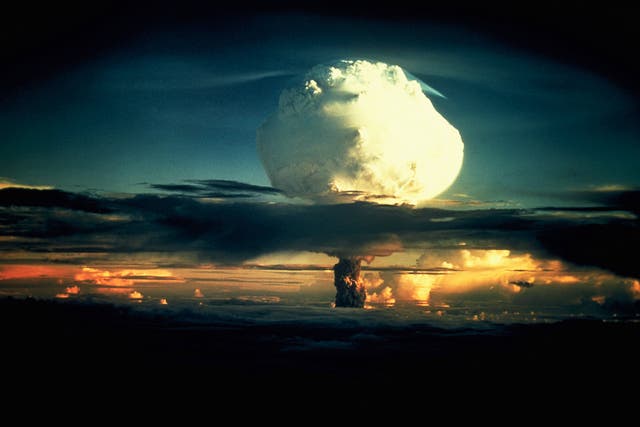 the first test of a hydrogen bomb, at Enewetak Atoll in the Marshall Islands. (Photo by © CORBIS/Corbis via Getty Images)" width="" height="" />
the first test of a hydrogen bomb, at Enewetak Atoll in the Marshall Islands. (Photo by © CORBIS/Corbis via Getty Images)" width="" height="" /> the first test of a hydrogen bomb, at Enewetak Atoll in the Marshall Islands. (Photo by © CORBIS/Corbis via Getty Images)" width="" height="" />
the first test of a hydrogen bomb, at Enewetak Atoll in the Marshall Islands. (Photo by © CORBIS/Corbis via Getty Images)" width="" height="" />
The Cold War was a period of geopolitical tension marked by competition and confrontation between communist nations led by the Soviet Union and Western democracies including the United States. During World War II, the United States and the Soviets fought together as allies against Nazi Germany. However, U.S./Soviet relations were never truly friendly: Americans had long been wary of Soviet communism and Russian leader Joseph Stalin’s tyrannical rule. The Soviets resented Americans’ refusal to give them a leading role in the international community, as well as America’s delayed entry into World War II, in which millions of Russians died.
These grievances ripened into an overwhelming sense of mutual distrust and enmity that never developed into open warfare (thus the term “cold war”). Soviet expansionism into Eastern Europe fueled many Americans’ fears of a Russian plan to control the world. Meanwhile, the USSR came to resent what they perceived as U.S. officials’ bellicose rhetoric, arms buildup and strident approach to international relations. In such a hostile atmosphere, no single party was entirely to blame for the Cold War; in fact, some historians believe it was inevitable.
By the time World War II ended, most American officials agreed that the best defense against the Soviet threat was a strategy called “containment.” In his famous “Long Telegram,” the diplomat George Kennan (1904-2005) explained the policy: The Soviet Union, he wrote, was “a political force committed fanatically to the belief that with the U.S. there can be no permanent modus vivendi [agreement between parties that disagree].” As a result, America’s only choice was the “long-term, patient but firm and vigilant containment of Russian expansive tendencies.”
“It must be the policy of the United States,” he declared before Congress in 1947, “to support free peoples who are resisting attempted subjugation…by outside pressures.” This way of thinking would shape American foreign policy for the next four decades.
Formation of NATOJust weeks before the match, Soviet tanks and troops brutally crushed the short‑lived Hungarian Revolution.
In the first half of the 20th century, U.S. educators shunned homework. The Soviet Union’s launch of Sputnik 1 changed that.
American and British pilots ferried some 2.3 million tons of supplies into West Berlin on a total of 277,500 flights, in what would be the largest air relief operation in history.